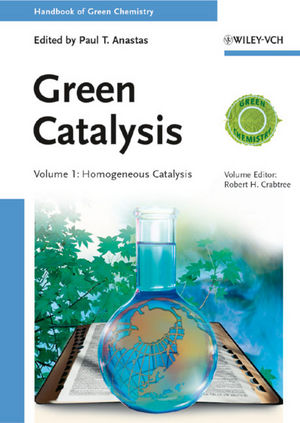Green Catalysis, 3 Volume SetISBN: 978-3-527-31577-2
Hardcover
1082 pages
August 2013
 |
||||||
Series Editor
Paul T. Anastas joined Yale University as Professor and serves as the Director of the Center for Green Chemistry and Green Engineering at Yale. From 2004-2006, Paul Anastas has been the Director of the Green Chemistry Institute in Washington, D.C. Until June of 2004 he served as Assistant Director for Environment at e White House Office of Science and Technology Policy where his responsibilities included a wide range of environmental science issues including furthering international public-private cooperation in areas of Science for Sustainability such as Green Chemistry. In 1991, he established the industry-government-university partnership Green Chemistry Program, which was expanded to include basic research, and the Presidential Green Chemistry Challenge Awards. He has published and edited several books in the field of Green Chemistry and is one of the inventors of the 12 principles of Green Chemistry.
Volume Editor
Bob Crabtree took his first degree at Oxford, did his Ph.D. at Sussex and spent four years in Paris at the CNRS. He has been at Yale since 1977. He has chaired the Inorganic Division at ACS, and won the ACS and RSC organometallic chemistry prizes. He is the author of an organometallic textbook, and editor-in-chief of the Encyclopedia of Inorganic Chemistry and Comprehensive Organometallic Chemistry. He has contributed to C-H activation, H2 complexes, dihydrogen bonding, and his homogeneous tritiation and hydrogenation catalyst is in wide use. More recently, he has combined molecular recognition with CH hydroxylation to obtain high selectivity with a biomimetic strategy.
Paul T. Anastas joined Yale University as Professor and serves as the Director of the Center for Green Chemistry and Green Engineering at Yale. From 2004-2006, Paul Anastas has been the Director of the Green Chemistry Institute in Washington, D.C. Until June of 2004 he served as Assistant Director for Environment at e White House Office of Science and Technology Policy where his responsibilities included a wide range of environmental science issues including furthering international public-private cooperation in areas of Science for Sustainability such as Green Chemistry. In 1991, he established the industry-government-university partnership Green Chemistry Program, which was expanded to include basic research, and the Presidential Green Chemistry Challenge Awards. He has published and edited several books in the field of Green Chemistry and is one of the inventors of the 12 principles of Green Chemistry.
Volume Editor
Bob Crabtree took his first degree at Oxford, did his Ph.D. at Sussex and spent four years in Paris at the CNRS. He has been at Yale since 1977. He has chaired the Inorganic Division at ACS, and won the ACS and RSC organometallic chemistry prizes. He is the author of an organometallic textbook, and editor-in-chief of the Encyclopedia of Inorganic Chemistry and Comprehensive Organometallic Chemistry. He has contributed to C-H activation, H2 complexes, dihydrogen bonding, and his homogeneous tritiation and hydrogenation catalyst is in wide use. More recently, he has combined molecular recognition with CH hydroxylation to obtain high selectivity with a biomimetic strategy.



